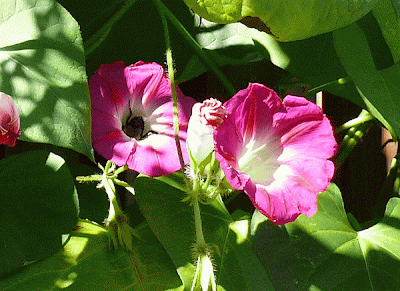I was surprised to learn that there are over 1,000 species of flowers referred to as morning glories from a number of different genera. They all belong to the taxonomic family Convolvulaceae. The family name Convolvulaceae comes from the Latin convolvere which means to wind - which is how morning glories grow up my porch, by winding their stems around and around the railing posts (it will be fun removing all of them soon). If the plant didn't have such beautiful flowers, it would be considered an obnoxious weed.
Morning glory is also infamous for its hallucinogenic properties. The seeds each contain about a microgram of a lysergic acid alkaloid called ergine (d-lysergic acid amide) similar to LSD. Sources on the Internet claim anywhere from 25 to 500 seeds are needed for an LSD-like trip (different sites have different numbers - I'm assuming it depends on how you prepare it, the species of morning glory used, when the seeds are harvested, and the phase of the Moon for all I know). I also have no idea if there's a lethal dose for morning glory seeds - I take no responsibility for anyone's actions in that regard.
Two species of morning glories, the tricolored Ipomoea violacea and the white-flowered Turbina corymbosa, were supposedly ingested in a tea-like infusion by Aztec priest/shamans in ancient Mexico (and still today by some indiginous tribes in Oaxaca). Here's a link to more information - no assurances as to its accuracy.
Just a word of warning to those tempted to engage in risky home pharmacology - don't seek your high from the seed packets purchased in stores since they're often treated with bioaccumulating toxic chemicals like methyl mercury to retard mold - I'm waiting for our idiotic government to make us show ID to buy morning glory seeds like we now have to for Sudafed (that really solved the meth problem, didn't it?).
The above is why there are companies on the Internet that sell "organic" morning glory seeds - since some of the companies have names like Shaman's Garden, it's not too hard to figure out what people are doing with these seeds.
Anyway, back to my mundane, non-trippy world. Here's a typical bloom (we have a few different colors going). I love the pentameral (5-fold) symmetry.
Here are a couple of blooms Sunday (October 3) with a bee still gathering nectar (and transporting pollen from one flower to another).
The inside of a ripped open flower laying bare the sex organs of the plant. The petals (5 fused together to form a funnel- or trumpet-shaped bloom) is called the corolla and the slightly hairy green leaves at the bottom (also 5 of them) are called the sepals or calyx. Note the white pollen (plant's version of sperm) dusting the inside of the flower from the stamens (filaments with elongate anthers on top produce the pollen).
Seed pods of the morning glory after the flowers drop off. Home to the spirits living in the seeds according to Mexican shamans.








geology professors are always awesome.
ReplyDeletemake yourself a nice cup of tea.
:)